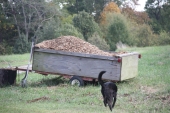
 1
1




It's C. Hopper but you can call me Chopper.








It's C. Hopper but you can call me Chopper.








 1
1








Eric Markov wrote:
"Hugelchar"' is a nice moniker!
It's C. Hopper but you can call me Chopper.




C Hopper wrote:Sadly I live in a townhouse with a homeowners association, thus I cannot test this idea until my wife and I obtain our dream of a homestead of our own.
Xisca - pics! Dry subtropical Mediterranean - My project
However loud I tell it, this is never a truth, only my experience...




Xisca Nicolas wrote: Why a homeowners association (I do not know what it is exactly...) prevents you from doing it?
It's C. Hopper but you can call me Chopper.




C Hopper wrote:I have been brainstorming how to efficiently make biochar. The TLUD seems rather inefficient as so much fuel is burned to heat the retort.
I have not tried any of this yet as I just put it onto paper yesterday, but here goes.
construct an outdoor rocket mass heater with the following differences:
1. instead of (or perhaps on top of) the big bell (heat riser) that radiates heat, place an old iron woodstove (or any sort of sealable durable metal container) that would function as the retort.
2. There could be a wood gas exhaust line (from the retort) with multiple valves to allow distribution to mulitiple useful ends (internal combustion electrical generator, cookstove, down into the rocket...)
3. The insulating mass would cover the entire apparatus with moveable insulation for the retort door.
4. no long warming bench for the rocket exhaust. Place heat exchanger fins under the retort in the heat riser chamber, to extract as much heat from the exhaust as possible.
I am only imagining how this would work from listening to podcasts and reading articles. But with the technicalities worked out and much experimentation I think that it could be a much more efficient means of producing biochar and usable wood gas for the homestead.
Here are a couple childlike drawings that I made during an HR meeting at work, lol.
It's C. Hopper but you can call me Chopper.




It's C. Hopper but you can call me Chopper.




My uncle always said, "Raising beds is better than wetting them".




C Hopper wrote:Sufficed to say that the rules prevent me from modifying the yard around my townhouse without approval from the association (all the other neighbors).
Xisca - pics! Dry subtropical Mediterranean - My project
However loud I tell it, this is never a truth, only my experience...




Xisca Nicolas wrote:
C Hopper wrote:Sufficed to say that the rules prevent me from modifying the yard around my townhouse without approval from the association (all the other neighbors).
Let's joke a little....
So, you have asked them in your head, and you have made their answer, and the answer is no!?
What you want to do is just some planting, and you want to raise the bed by introducing an organic safe product into the soil, are you sure they will not accept it? Or is your backyard not made of earth but of cement/cobblestones!




Xisca - pics! Dry subtropical Mediterranean - My project
However loud I tell it, this is never a truth, only my experience...











